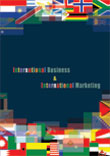International Business and International Marketing
 |
Details
Textbook:
Pages : 328;
Paperback;
210 X 275 mm approx.
Suggested Case Studies
Workbook:
Pages :
280; Paperback;
210 X 275 mm approx, Sample Applied Theory Questions
Sample Multiple Choice Questions (Online Quiz)
Pricing
Textbook Price: Rs. 750;
Workbook Price: Rs. 700;
Available only in INDIA
Buy Now
Please allow 5 to 10 days for delivery.
Detail Table of Contents
Segmentation, Targeting, and Positioning : Chapter 8
SUMMARY:
Companies that serve global markets, divide them into several clusters on the basis of similarities. And each such cluster is known as a segment. Segmentation helps marketers to serve the markets in a better way. Markets can be segmented in nine ways, but the most popular form is on the basis of individual characteristics, which include the demographic, psychographic and behavioral segmentations. Demographic segmentation is done on the basis of factors like age, gender, income, culture, and education. |
|
The current size and growth rate of the market, potential competition, and compatibility and feasibility are the three basic criteria for targeting the markets. After targeting the market, companies should select a global market strategy.
There are three types of global market strategies available for firms. They are: undifferentiated global market strategy, concentrated global market strategy and differentiated global market strategy. As the next step, firms should position their product in the global market. Product positioning is nothing but creating a favorable impression of the product against the competitor's products in the minds of customers.
Product categories usually opt either for high-tech or high–touch positioning in global markets. High-tech products may be further divided into three categories such as technical products, special interest products, and demonstration products. High-touch products are also divided into three categories -- products that solve common problem, global village products, and products that use a universal theme.
Marketing in less developed countries offers several advantages to organizations. They can exploit the huge untapped markets and avail of tax benefits. By targeting the less developed countries, firms can expand their market share and become market leaders. Less developed countries provide certain special benefits for new firms to establish their operations in their countries. Thus, marketing in less developed countries proves to be very advantageous for firms operating at the global level.



